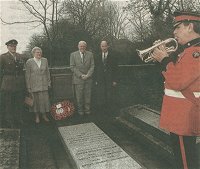Arthur Martin-Leake facts for kids
Quick facts for kids
Arthur Martin-Leake
|
|
|---|---|

Arthur Martin-Leake c. 1902
|
|
| Born | 4 April 1874 Standon, Hertfordshire, England |
| Died | 22 June 1953 (aged 79) High Cross, Hertfordshire, England |
| Buried |
St John's Church, High Cross
|
| Allegiance | United Kingdom |
| Service/ |
British Army |
| Years of service | 1899–1902 1914–1918 |
| Rank | Lieutenant Colonel |
| Unit | Imperial Yeomanry South African Constabulary Royal Army Medical Corps |
| Commands held | 46th Field Ambulance |
| Battles/wars | Second Boer War First World War |
| Awards | Victoria Cross & Bar Mentioned in Despatches Colonial Auxiliary Forces Officers' Decoration |
Arthur Martin-Leake (born April 4, 1874 – died June 22, 1953) was a brave British doctor and army officer. He served in the Royal Army Medical Corps, which is the medical part of the British Army.
Arthur Martin-Leake is famous for being one of only three people to win the Victoria Cross (VC) twice! The Victoria Cross is the highest award for bravery given to soldiers in the British and Commonwealth forces. It's given for amazing courage when facing the enemy.
Contents
Early Life and Becoming a Doctor
Arthur was born in Standon, Hertfordshire, England. He went to Westminster School and then studied medicine at University College Hospital. He became a qualified doctor in 1893.
Before joining the army, he worked at a hospital in Hemel Hempstead. In 1899, he joined a special army unit called the Imperial Yeomanry to serve in the Second Boer War.
Bravery in the Boer War
After his first year of army service, Arthur Martin-Leake stayed in South Africa as a civilian doctor. He then joined the South African Constabulary, which was a police force. He had to return home later because he was wounded.
He was 27 years old when he earned his first Victoria Cross. This happened on February 8, 1902, during the Second Boer War. He was a surgeon captain, meaning a doctor with an army rank.
Here's what he did to earn the award:
During a battle, Surgeon-Captain Martin-Leake went to help a wounded soldier. He did this while under heavy enemy fire from about 40 enemy soldiers who were only 100 yards away. He then went to help a wounded officer. While trying to make the officer comfortable, he was shot three times. But he didn't give up until he was completely exhausted. All eight men at that spot were wounded. While they lay on the ground, Surgeon-Captain Martin-Leake refused water until everyone else had been given some.
King Edward VII personally gave him this award on June 2, 1902.
Between the Wars
After recovering from his wounds, Martin-Leake continued his medical studies. In 1903, he became a Fellow of the Royal College of Surgeons. This is a special achievement for doctors.
He then moved to India to work as the Chief Medical Officer for a railway company. In 1912, he volunteered to help the British Red Cross Society during the Balkan Wars. He worked with the Montenegrin army and was present during a big battle called the Siege of Scutari (1912–13). He received an award from Montenegro for his help.
Heroism in the First World War
When the First World War began, Martin-Leake rejoined the British Army. He served as a lieutenant with the 5th Field Ambulance, part of the Royal Army Medical Corps. He was sent to the Western Front, where much of the fighting happened.
He earned his second Victoria Cross when he was 40 years old. This happened between October 29 and November 8, 1914, near Zonnebeke, Belgium.
His award citation said:
Lieutenant Arthur Martin Leake, Royal Army Medical Corps, who was awarded the Victoria Cross on May 13, 1902, is granted a Clasp for amazing bravery in the current war: —
For very amazing bravery and dedication to duty throughout the war, especially from October 29 to November 8, 1914, near Zonnebeke. He rescued many wounded soldiers who were lying very close to the enemy's trenches, while constantly under fire.
His Victoria Cross medals are now on display at the Army Medical Services Museum in Aldershot, England.
He was promoted several times during the war. He became a captain in March 1915 and a major in November of the same year. In April 1917, he took command of the 46th Field Ambulance unit as a lieutenant colonel.
Later Life
After the First World War ended, Martin-Leake left the army. He went back to working for the railway company in India until he retired in 1937.
During the Second World War, he continued to serve his country. He was in charge of an ARP post, which helped protect people during air attacks.
Arthur Martin-Leake passed away at the age of 79 in High Cross, Hertfordshire. He was buried in St John's Church, High Cross. There is a special plaque and a tree dedicated to him at the National Memorial Arboretum in Alrewas, Staffordshire.



